OBJECTIVES
Upon completion of this lesson, you will become familiar with:
- Define Water Rescue Incidents
- List the equipments used in water Rescue
- Explain terminology used for boats and Type of Boats
- Describe the terminology and water flow type of rivers
- List the basic techniques of water rescue
- List the zones at operation site
- List the methods of communication
- List the types of search
- Describe Floods and list the Phases of Flood and it Hazards
- List parts of SCUBA and OBM
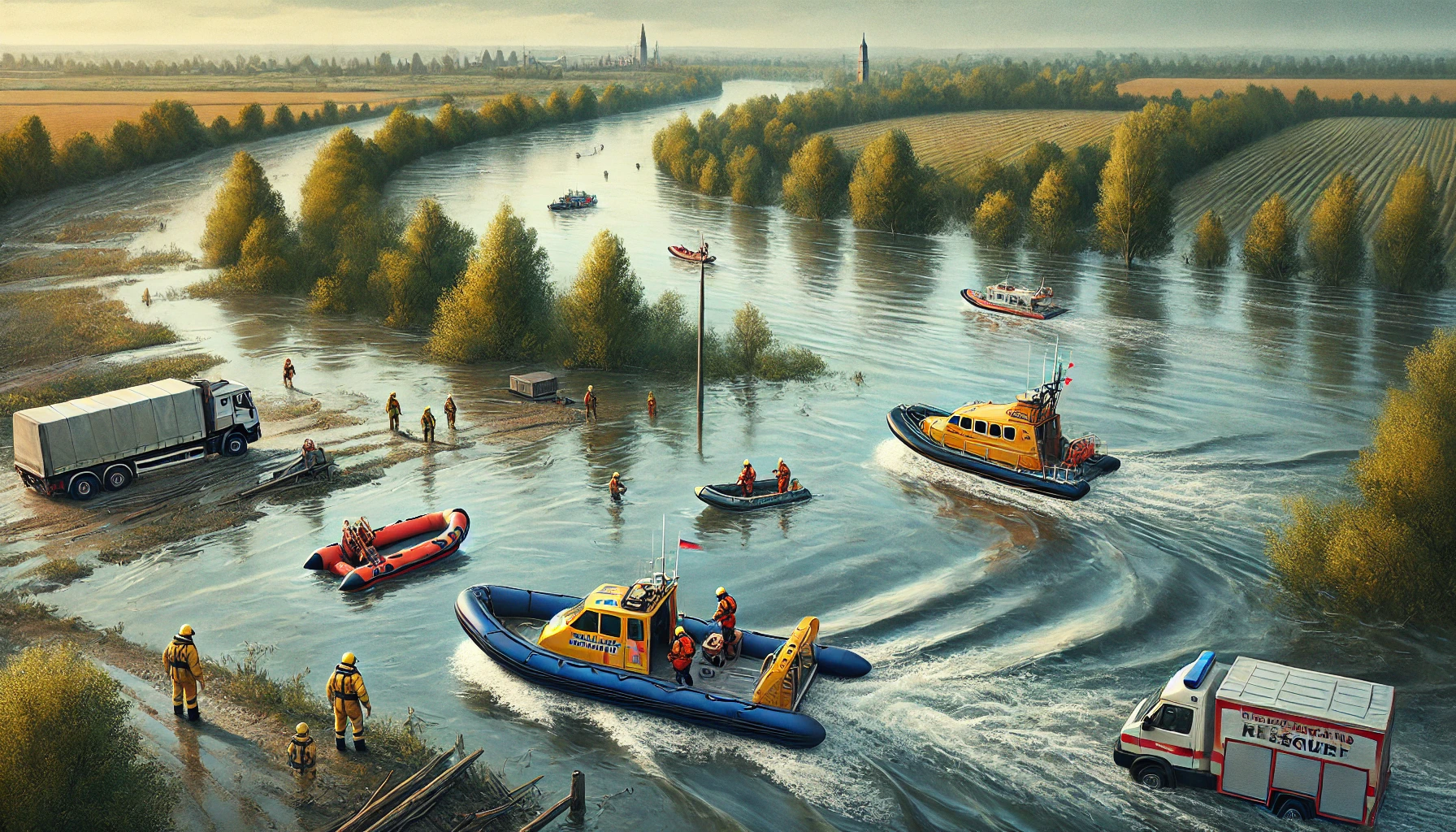
1. Water Rescue Incidents
Any incident that takes place in or around water. As with any search and rescue (SAR) mission, the first component of a swift water rescue is to locate the victims. However, actually finding the victims can be the most difficult task. Whether it is a natural river channel, a flood plain or a man made canal, the sheer size of the search area can itself be daunting. In addition, possible access routes to these locations can be few and far between, and the routes themselves can create problems. Searches may operate at night or in adverse weather conditions – both potential problem conditions for rescuers.
As with other type of rescue, the keys to overcoming the challenge of finding victims in the water are:
- Preparation
- Practice
- Common Sense
2. Water Rescue Equipment
The personal protective equipment (PPE) used in water rescue is both specialized and specific which is meant to protect rescuers from discomfort, injury or even death. Just as firefighters would not wear a dry suit to attend a fire scene. Similarly fire proof clothing is not suitable for water rescue mission. Water Rescue teams may carry vast range of equipment, depending on the level of operation and protection from submersion, thermal and contamination risks. Rescue personnel need to be properly equipped for the situations they face and the role they intend to perform. Before equipment is chosen it is necessary to look at the hazards that rescuers need protection from.
Water Rescue Protective Equipment

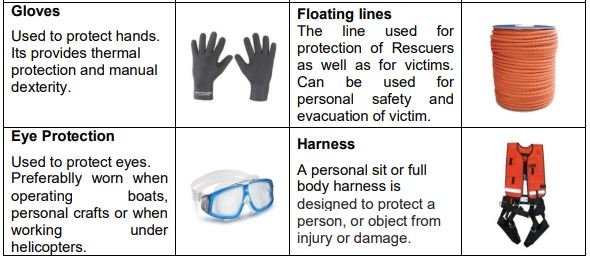
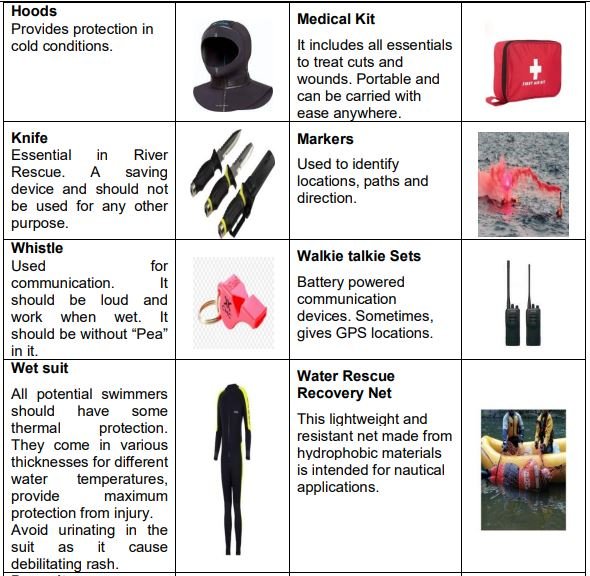


Advance Devices


Personal Flotation Device (PFD)
A Personal Flotation Device is any device which assists a person to float. Life jackets and buoyancy aid are both different types of PFDs. PFDs come in various types and levels of buoyancy. Some are foam filled, others gas inflated, and some a combination of both. Life jackets are designed for accidental immersion they are intended to provide buoyancy and to maintain the body a position that protects the airway. They are not designed to swim in, or as a rescue device.
- Type 1 Off-Shore Life Jacket
- Type 2 Near-Shore Buoyant Vest
- Type 3 Flotation Aid
- Type 4 Throw-able Device
- Type 5 Special-Use Device
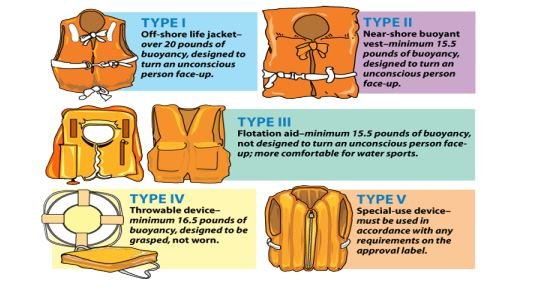
3. Terminology of Boats:
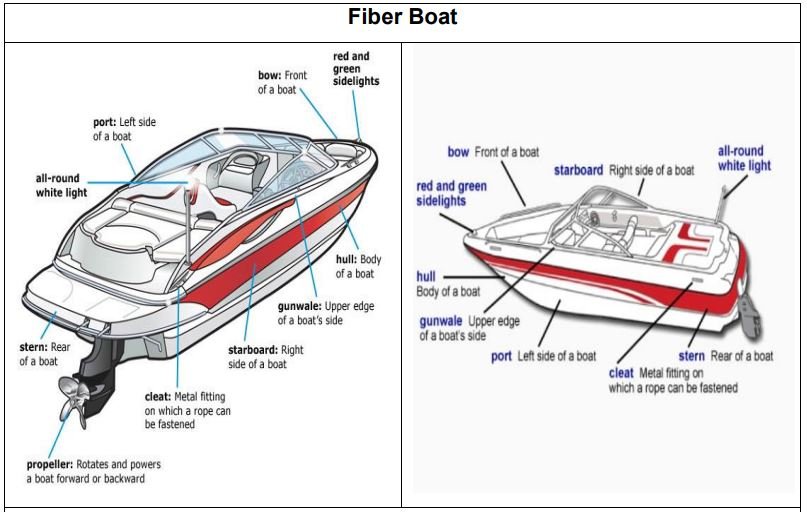

3.1 Type of Boats:
1. Inflatable Rescue Boat
These tend to be smaller boats with a raft-like construction. They can be rolled up for transportation and launched very easily. They have a rigid transom on which to attach an engine, and can have a semi-rigid floor i.e. a number of aluminum strips covered with Hypalon. They sometimes have an inflatable keel which improves directional control and helps in rough water. IRB’s tend to be maneuverable in whitewater and can also be handled reasonably efficiently without the motor. They are also compartmentalized like whitewater rafts. This type of boat is proving to be very popular with a lot of emergency services and rescue teams due to its versatility and friendly handling characteristics, along with its ease of carrying to and launching at rescue sites. These boats are approximately 08 to 14 feet long and work better in flood operations. As it is lightweight, it can easily be waded in shallow water. It has 4 to 6 chambers which make it more reliable in case of punctures. It can be inflated easily by foot pump, electric pumps, or using pressurized charged cylinders.
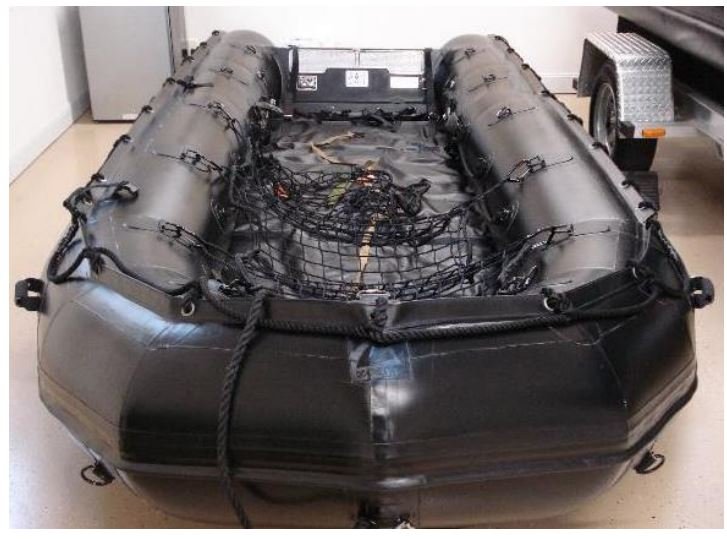
2. Rigid Hull Craft
Rigid hulled boats come in a huge variety of shapes and sizes; they can have flat bottoms or deep V’s. They can be made of a wide variety of durable materials such as aluminum, wood, or plastic fibers. Some boats have a double skin or built-in buoyancy compartments which keep the boat afloat if it swamps. The deeper “V” of boat provides less initial stability, but it tackles rough weather and waves better. Almost all will need a trailer and slipway to launch. This type of boat is easily available and can be very versatile as long as the limitations of its particular design are respected. These boats are approximately 12 to 19 feet long and work better in flood operations.
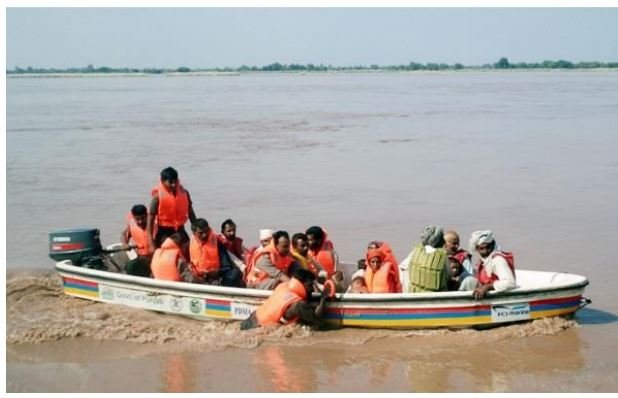
3. Rigid Inflatable Boat (RIB)
This is a great combination of the rigid hull for speed and directional stability, with the forgiving nature and stability of the inflated side tubes. The larger size of a RIB (compared to the IRB) allows it to use much more powerful engines. Larger ribs can have a central console with a wheel and throttle control, which gives a better view of the water and victim.
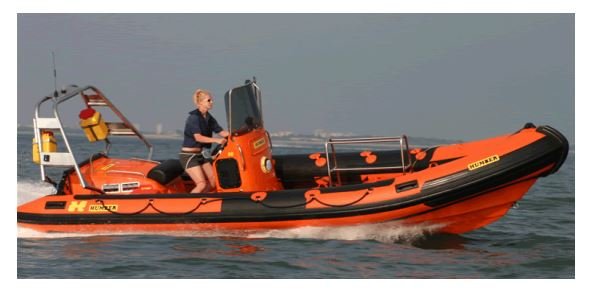
4. TERMINOLOGY AND WATER FLOW TYPE OF RIVERS

- Upstream
The direction that the water is flowing from. - Downstream
The direction that the water is flowing to. - River right
The right side of the channel when looking downstream - River left
The left side of the channel when looking downstream. An important thing to remember is that ‘river right’, and ‘river left’ are always set relating to the flow of the water, and not the viewer’s perspective. - Bank
The raised ground at the side of river. - Bend (River Bed)
It is the ground at the bottom made up of sand, stones and sediments. - Channel
A grove in the land where a river flows. - Flow Types
Streams, river and water channel alters the earth landscape through the movement of sediments. Streams are powerful erosive agent which move material from their bed and banks.
There are two types of current flows encountered in moving water channels.
I. Laminar Flow
All the water in a channel does not travel at the same speed however water flow remains same. Layers of water in contact with the channel bed and sides are slowed down by the effects of friction. The water closer to the middle is slowed down by friction against the slower water. The fastest flow is in the center of the channel just below the surface – furthest from the bank.
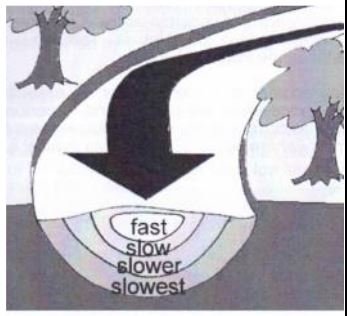
II. Helical Flow
Spiral flow in stream caused by channel shape. This is a spiraling effect caused by the banks slowing down the water at the edge of the river and the faster movement of mid channel water. It is a relatively unusual feature in natural channels, unless they are full to the top, and travelling at their maximum speed. The helical flow can push a casualty and river debris away from bank into the center of the river.
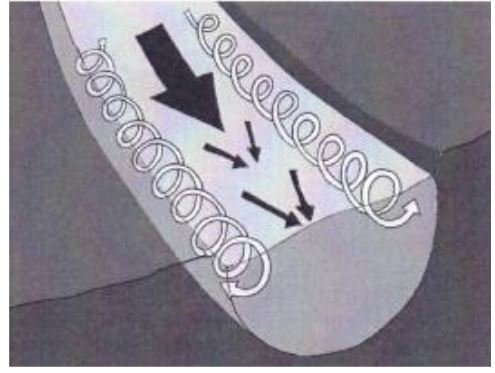
III. Turbulent Flow
Irregular movements / mixing of water. Water flows as discrete eddies and vortices caused by channel topography and friction.
5. Water Rescue Techniques
Historically the ‘mantra’ of Talk – Reach – Throw – Row – Go-Tow – Hello has been viewed as a rescue hierarchy. The order in this manual starts with the simplest of methods and increases with more complex methods, which require more equipment and familiarity with the techniques as they get more complex. This division can be thought of as conditional rescues and true rescues.
A Conditional Rescue relies upon the casualty doing something to assist. For example, throwing a rope to the casualty would require them to have the knowledge, presence of mind, and physical capability to hold onto the rope, and grip it tightly until they are safe.
A True Rescue requires no assistance from the casualty. The rescuer must do everything, and so must be correctly equipped and trained to perform the rescue. Clearly, the risk to the rescuer is higher, as they must go into the hot zone; however the benefit to unconscious or injured casualties is obvious.
I. Reach
The length of the reaching aid is the limiting factor with this rescue. Throw bags, inflated fire hoses, ladders, and wading poles have all been used to good effect. Even though a throw bag is thrown, the rescuer maintains contact with the end of the rope, so is effectively extending their reach. In this skill, victim is in access and can be grabbed by arms, hairs, cloths etc.
II. Wade
Entering shallow slow-flowing water in order to perform a throwing, reaching, or contact rescue is a relatively low risk option (for appropriately trained personnel), which can significantly increase the chance of a successful rescue. Particularly in flooded environments the majority of successful rescues involve wading with casualties. Entering the water to wade is the upper limit of the skills of a First Responder.
III. Throw
Accuracy is important, as stated above – establish eye contact and communications with the casualty to ensure they are expecting the object thrown. The object thrown must be buoyant, and the rescuer does not have any contact with it after throwing, such as a Perry Buoy except floating line attached with this.
Shout & Signal
Communicate with casualty by any means available. Establishing eye contact is very useful. Always maintain a positive attitude and be encouraging. Keep communications short and to the point. This rescue can be performed by anybody. Encourage and guide victim to stay away from main flow, hold the coming, leaning branch of tree etc.
Craft
Rescuers are now moving into higher risk hot zones, albeit floating above the water. There are a wide variety of craft that can be used to perform successful rescues. Inflatable pathways, RIBs, PWCs, hovercraft, inflatable boats, rafts, canoes, kayaks, and many others. It helps rescuers to approach victims easily.
Swim
Using all their skills, Swift water Rescue Technicians will be able to perform inwater contact rescues to rescue any casualty, regardless of their level of consciousness or injuries.
Helicopter or Aerial
It is worth remembering that sometimes rescues will be beyond the skill level of a Swift water Rescue Team. Perhaps calling in a helicopter or a rope rescue team to setup a highline system. High-angle rescue is a major topic of the Swift water Rescue Technician.
6. Zones Regarding Water Rescue Incident
When dealing with water rescue incidents, it is advisable to zone the working area as soon as possible. By only permitting suitably trained and equipped people into each zone, the safety of the team is ensured. In effect, a safety cordon is established.
- Hot Zone
The hot zone is the area covered by water. This is often the greatest hazard, and must be approached by the right people capable of working safely in that environment. Rescues will be performed by a variety of methods and the personnel in this area need to be properly trained and equipped for the situation. - Warm Zone
This area moves inland, away from the water to a minimum of three meters (terrain dependent). There is a chance of personnel in this area to accidentally slip and fall into the water. Personnel must be equipped and trained to deal with this possibility. If necessary, this area can be extended further from the water’s edge due to the terrain; for example, slopes or uneven ground. - Cold Zone
This is an area for personnel trained at Awareness level; they do not intend to approach the warm zone and certainly not the hot zone. Personnel in the cold zone might be medical teams and additional support staff. Regardless of the level of training, if an individual does not have appropriate PPE, then they must not progress any further than the cold zone.

7. Communications
Often the difference between success and failure is effective communication. For an incident to run smoothly, there must be a method of communication between all members of a team, and between the Incident Commander and the team. This may be done simply, by voice or signaling to each other. However, there are many more technical methods such as a handheld radio system. If a technical method of communication is relied upon, a backup method must be immediately available. Rescuers should remember that radios can break, and batteries can run flat. Reliance upon a single method of communication is dangerous. Whatever method is used, it is essential that all team members recognize and understand it. Where necessary the message should be confirmed back to confirm understanding. Often the river bank is a noisy environment and not conducive to good communication. So it is vital that communications are clear, concise and understood by all. Some other means of communication may be used according to scene.
- Hand signals
- Whistle signals
- Radios
- Megaphone
- Lifeline
- Torch
- Umbilical cord
- Decided time

8. Type of Search
- Circular Search
- Enclosed Water Grid Search
- Open Water Grid Search
- Seabed Snag Line Search
- Progressive Snag Line Search
- Light Weight Snag Line Search
- Towed Diver Search
…………………………………………………………………………………….
…………………………………………………………………………………….
…………………………………………………………………………………….
…………………………………………………………………………………….
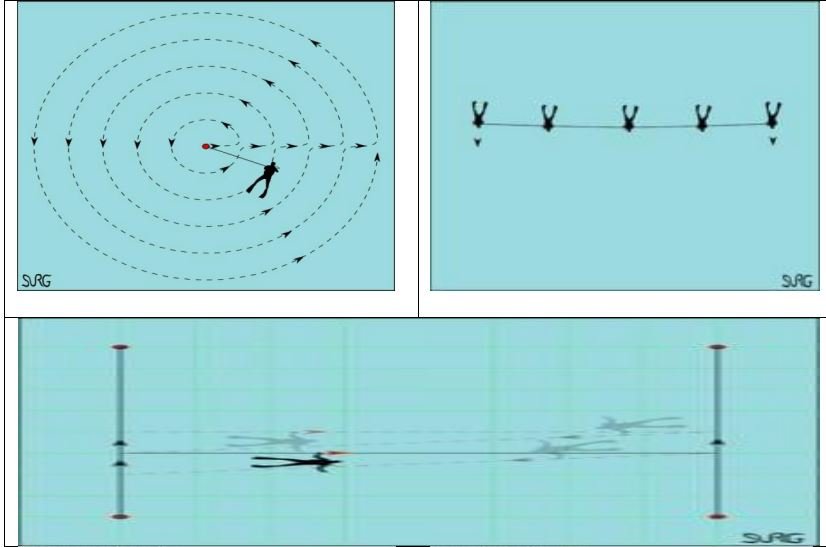

9. FLOOD
An overflow of a large amount of water beyond its normal limits, especially over what is normally dry land. River levels will vary greatly depending upon factors such rainfall, snowmelt, release from upstream dams etc. However most of the time the river level will be within the river channel. Therefore its flow and features are relatively predictable. As river levels rise they will eventually reach a point where they are ‘bankfull’ and any subsequent rise will see the riverbanks overtopped and the water flowing through the adjacent low areas of land, the floodplain.
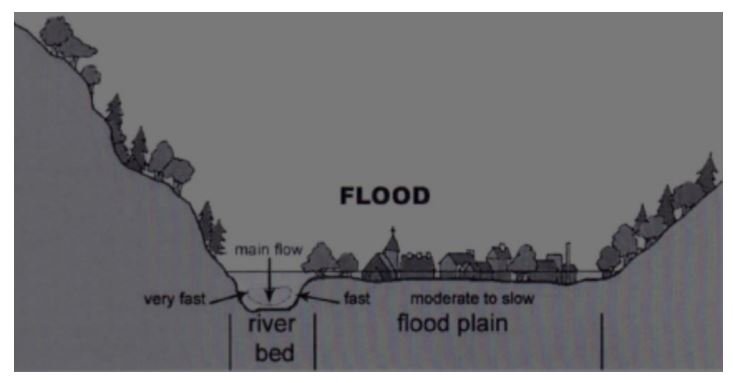
Phases
Flood incidents may be broken down into four phases. Every flood will progress through these phases, although because each flood is unique, it will progress at a different speed.
Phase 1 Pre flood
Flooding has not yet occurred. However, it will at some point in the future. Now is the time to develop a response plan based on an existing hazard assessment that includes historical flood data. This is also a good time to train personnel and invest in equipment. Public education during this phase can be invaluable for when the flood event occurs.
Phase 2 Flash flood
Streams, rivers, storm drains and waste water management systems are full. Water is just beginning to escape waterways, to cover roads, and to impact property. This phase is associated with high speed water. Most technical rescues will occur during this phase. People are caught unawares and lives are in imminent danger. During this phase rescuers will be at their greatest personal risk.
Phase 3 – Expansion
Streams and rivers are now clearly out of their banks and the water is moving laterally. Land is now being lost significantly, which means that access and egress will also be compromised. This phase is evacuation intensive since structures, regardless of their occupancies, are now impacted. As essential infrastructure is now being compromised, hazmat issues begin to surface. Evacuation means that people can leave under their own power – which is often not the case here. If people are being moved by rescue teams (for example by boat), then rescues are taking place. The new term is “rescue evacuation” which consumes resources and time.
Phase 4 Recovery
Structures and roads should be inspected. Infrastructure restoration and hazmat issues are now the most pressing. Due to hazmat issues, public health agencies will be very busy. Search and Rescue work will stop, and turn to Search and Recovery. The use of rescue resources (especially inflatable boats) must be adjusted due to the decreasing water levels and emergence of new hazards. Emergency personnel should be closely monitored for fatigue, and the personal losses they may have suffered.
Flood Hazards
The ability to recognize and risk assess hazards is a vital skill. Each hazard must be identified and addressed before performing a rescue. There is an enormous variety of hazards in a swift water and flood environment, a small selection are outlined below:
Utility Hazards
- Electricity
- Natural gas
- LPG and oil tanks
- Chemical and Biological Hazards
Possible HazMat locations
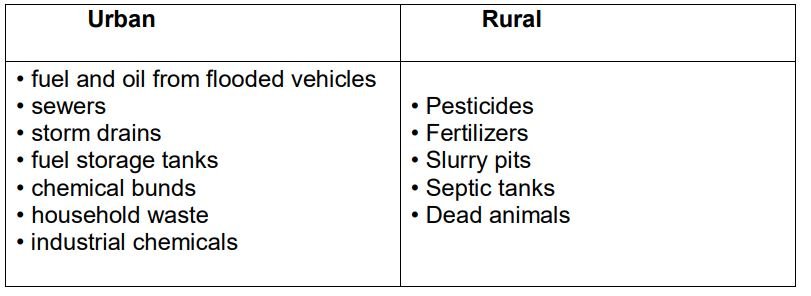
Physical Hazards
In addition to generic hazards of swift water, there are a number of other common physical hazards.
- Undercuts
- Siphon
- Inspection Covers
- Debris
- Strainers
- Cold water
- Weirs

10. SELF-CONTAINED UNDER WATER BREATHING APPARATUS
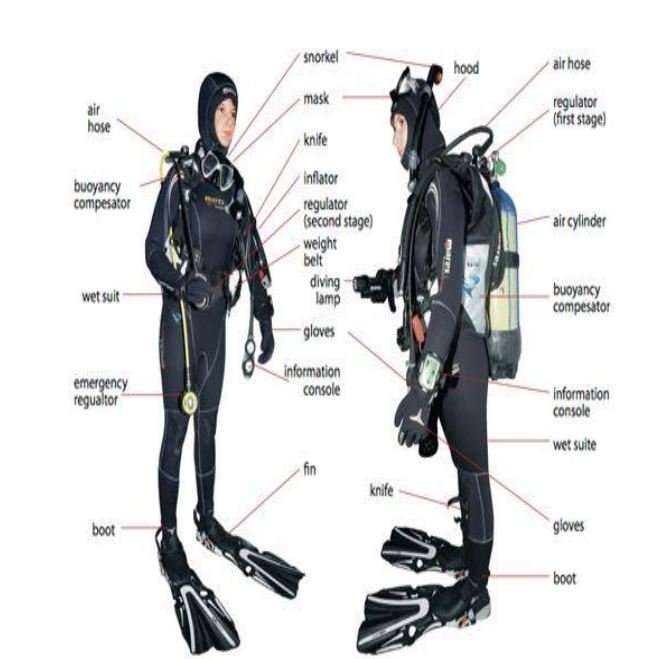
OUT BOARD MOTOR (OBM)
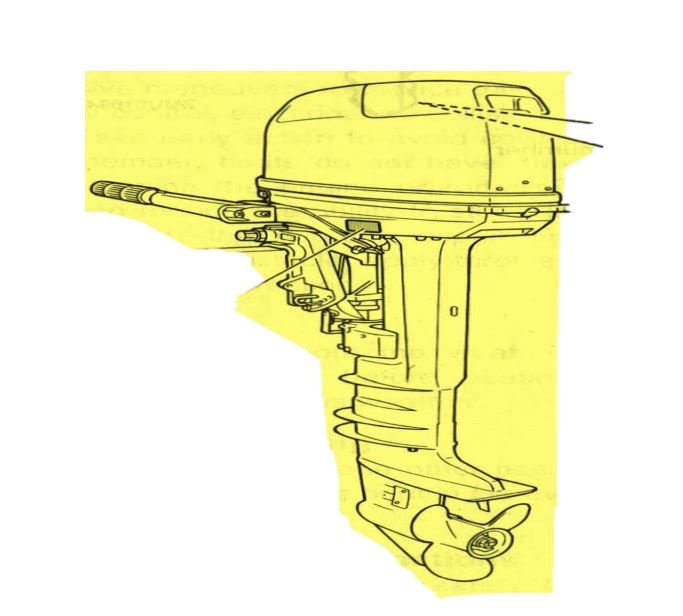
OBM PARTS
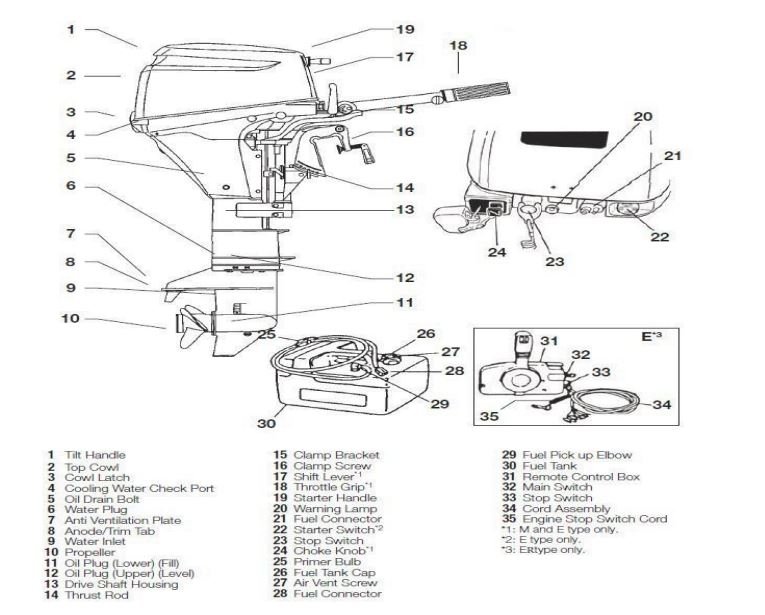
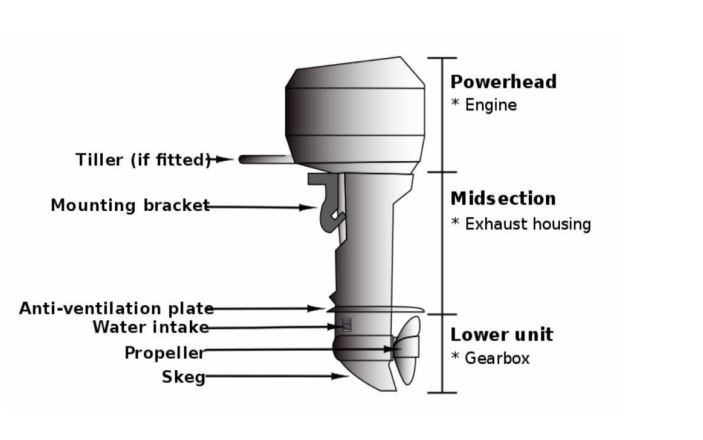

Emma Lee, an expert in fire safety with years of firefighting and Rescuer experience, writes to educate on arescuer.com, sharing life-saving tips and insights.
